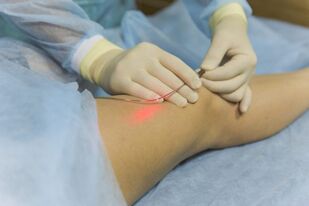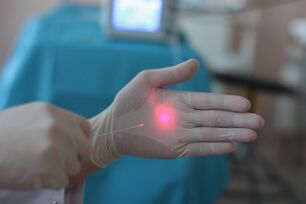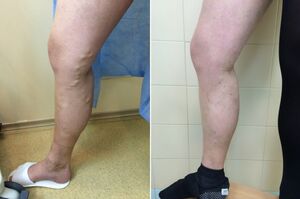A disease in which the veins enlarge, dilate and lose elasticity is known as varicose veins. The result of the disease is not only a noticeable cosmetic defect, but also the formation of ulcers, which is accompanied by severe pain. Laser treatment of varicose veins of the lower extremities is one of the most modern and painless methods of removing the disease.
Procedure transcript

Laser treatment of varicose veins is performed using an ultrasound duplex scanner. In this case, the absorption of laser energy by erythrocyte hemoglobin occurs.
As a result, within a few seconds they are converted into heat energy whose value reaches 100 degrees. Blood plasma and its elements boil. This procedure can be compared to some kind of heat burn of the venous walls, which causes the formation of a blood clot.
After a short period of time, the veins dissolve and become almost invisible. If the disease is in an advanced form of development, it is necessary to repeat the operation. This can be done in 30-40 days at the earliest.
The popularity of the method is a result of its inherent advantages. Among the most significant are the following:
- The operation is performed on an outpatient basis. The patient spends only a few hours in the clinic.
- The procedure does not require the use of general anesthesia. It is sufficient to anesthetize only the site where the laser catheter is inserted into the vein. Thanks to that, the rehabilitation period is significantly shorter.
- There is no need for drug therapy after surgery.
- Experts monitor the progress of the operation using color Doppler ultrasound monitoring. This guarantees the accuracy of the procedure.
- After surgery, there are no postoperative sutures, stitches or other cosmetic defects on the patient's surface.
- The postoperative period does not require bed rest.
- The operation is performed using a single instrument intended for endovascular intervention. Thanks to this, the risk of infection in the body is minimized.
The presence of these and other benefits confirms the efficiency and effectiveness of the laser varicose vein removal procedure.
Indications for laser surgery
Laser treatment of varicose veins is indicated for those patients who have been diagnosed with enlargement of the great and small saphenous vein. In this case, the size of the expansion of the venous opening does not exceed 1 cm, and the vessels are evenly spaced, without creating numerous bends.
The use of lasers will only be effective when the disease is at an early stage of development.
For which this method is prohibited

Laser removal of veins on the legs is not recommended if the disease is in the second, third or fourth stage of development. The reason is that it is possible for the vein to enlarge again.
In addition, it should be noted that the laser acts on a small area of the vein, which allows to avoid damage to the surrounding tissues. If a person has lesions of a large area of veins, the use of laser therapy will not give the desired result.
If we talk about the contraindications to the use of lasers, they can be roughly divided into 2 groups:
- Absolutely.This includes those cases in which the use of lasers is strictly prohibited:
- the patient has the possibility of developing thrombophlebitis;
- chronic blood diseases are observed;
- vein walls have serious lesions.
In these cases, the use of lasers can cause fatty blood clots.
- Relative.This group includes contraindications that force to delay laser surgery for a while:
- the presence of wounds or ulcers on the surface of the patient's skin. They need to be cured first. Otherwise, the possibility of complications in the postoperative period is not excluded;
- period of pregnancy and lactation. At this point the female body is weakened, and there is a great strain on the lower limbs;
- overweight.
If the patient has contraindications from the first group, experts recommend using the second method of treating varicose veins. If there are relative contraindications, it is necessary to get rid of them before using laser therapy.
Preparation

One of the advantages of laser vein treatment is that the patient does not have to go through a long preparation period.
Preparation before surgery consists of performing a standard examination, which includes the following manipulations:
- analysis of blood and urine, in which the presence of sugar levels is determined, the degree of blood coagulation is determined, blood biochemistry is performed, Rh factor and blood group are determined;
- HIV testing and the presence of sexually transmitted diseases;
- fluorography;
- with the help of ultrasound, experts precisely determine the place of expansion on the veins of the legs;
- If the patient is very upset, sedatives are given.
After completing these manipulations, you can proceed to the operation itself.
Which method to choose
Several effective methods can be used to treat varicose veins, in addition to endovascular laser coagulation. Among the most popular are the following:
- Compression therapy.The essence of the method is the use of external compression of veins, which leads to a reduction in their size. After the operation, it is possible that the vein will increase. In most patients, there is a need for lifelong compression therapy. Laser vein surgery on the legs eliminates this need.
- Phlebectomy.In this case, the vein is surgically separated from the general vein system. In this case, the diseased vein is completely removed, which minimizes the recurrence of the disease. The disadvantage of this method is the mandatory use of general anesthesia, which leads to an increase in the rehabilitation period to 3-4 weeks.
- Sclerotherapy.This is an invasive treatment that uses a special foam. The patient is injected with sclerosant, which causes the vessel to stick. The possibility of developing such postoperative consequences as tissue scars, skin surface necrosis, allergies, migraines and others is not excluded.
- Radiofrequency vein obliteration.Conducted using radio waves. The catheter is inserted into a vein. Radio waves cause heat to build up and stick to the walls of the veins. This method is contraindicated in patients with pacemakers or defibrillators.

Of all the above methods, EVLO varicose veins are the most gentle and effective. The final decision on the choice of method for the treatment of varicose veins can be made only after a thorough general examination and recommendation of a phlebologist.
Perform operation
Laser varicose vein removal is a manipulation that lasts a maximum of 30 minutes. It is performed in several stages:
- In accordance with the previously prepared map of the patient's veins, the specialist performs local anesthesia where punctures will be performed; a laser-equipped
- catheter is inserted into the vessel cavity;
- The catheter is gradually moved to the groin area, then pulled back. In this case, energy is emitted, which leads to sealing of the vein.
In order not to damage the mucous membrane of the eye, the patient must first wear goggles.
How long
One of the advantages of the laser coagulation method on the legs is that the operation itself takes no more than 30 minutes.
After this time, the patient can leave the clinic on his own. The short duration of the method is a consequence of the absence of general anesthesia, as well as surgical incisions on the surface of the skin on the patient's legs.
Postoperative recovery
Laser therapy of varicose veins includes a short postoperative period. To pass properly, experts recommend that the patient adhere to the following rules:
- wear compression garments;
- avoid heavy footwork;
- walk in nature as much as possible;
- perform an ultrasound scan 10-14 days after surgery. This will give specialists a picture of the condition of human veins at the sites of intervention.
Within 2-3 months, the patient fully recovers and is ready to lead his normal life.
Results and possible consequences
If laser vein surgery is performed in a timely manner, the probability of the disease coming back is very small. The patient returns to his normal and familiar lifestyle after a few months.
Negative consequences after surgery to remove varicose veins in the legs are very rare. This can usually be mild skin pigmentation at the sites where the puncture was performed. It can be eliminated by taking medication.
Average price of laser treatment
It is safe to say that the cost of laser treatment of varicose veins on the legs is the only drawback of the method. It depends on factors such as the degree of disease development, the equipment used for the operation, the individual characteristics of the patient and other factors.
Despite the high cost, this method is recognized as the most effective in the world.























